2021 |
||
| 30. | 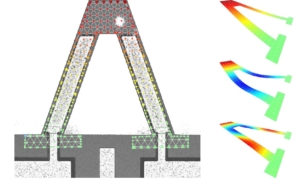 | M. G. Ruppert; N. F. S. de Bem; A. J. Fleming; Y. K. Yong Characterization of Active Microcantilevers Using Laser Doppler Vibrometry Book Chapter In: Vibration Engineering for a Sustainable Future , Chapter 45, Springer, 2021, ISBN: 978-3-030-48153-7, (This work was supported by the Australian Research Council Discovery Project DP170101813). Abstract | Links | BibTeX | Tags: AFM, Cantilever, DP170101813, MEMS, Piezoelectric Transducers and Drives, Smart Structures @inbook{Ruppert2021b,Active atomic force microscope cantilevers with on-chip actuation and sensing provide several advantages over passive cantilevers which rely on piezoacoustic base-excitation and the optical beam deflection measurement. Most importantly, these cantilevers provide clean frequency responses, the possibility of down-scaling and parallelization to cantilever arrays as well as the absence of optical interferences. In this paper, we demonstrate the analysis and calibration steps for three active cantilever geometries with integrated piezoelectric actuation. For this purpose, laser Doppler vibrometry (LDV) is used to experimentally obtain the deflection mode shapes of the first three eigenmodes, calibrate actuation gains, and to determine the dynamic modal stiffnesses using the Brownian spectrum of the cantilever. The experimental values are compared with finite element simulations. |
| 29. | 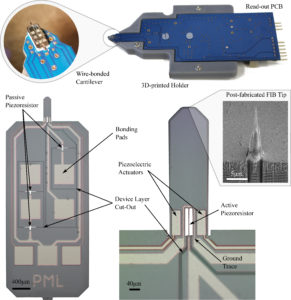 | M. G. Ruppert; A. J. Fleming; Y. K. Yong Active atomic force microscope cantilevers with integrated device layer piezoresistive sensors Journal Article In: Sensors & Actuators: A. Physical, vol. 319, pp. 112519, 2021, ISSN: 0924-4247, (This work was supported by the Australian Research Council Discovery Project DP170101813). Abstract | Links | BibTeX | Tags: AFM, Cantilever, DP170101813, MEMS, Sensors, Smart Structures @article{Ruppert2021,Active atomic force microscope cantilevers with on-chip actuation and sensing provide several advantages over passive cantilevers which rely on piezoacoustic base-excitation and optical beam deflection measurement. Active microcantilevers exhibit a clean frequency response, provide a path-way to miniturization and parallelization and avoid the need for optical alignment. However, active microcantilevers are presently limited by the feedthrough between actuators and sensors, and by the cost associated with custom microfabrication. In this work, we propose a hybrid cantilever design with integrated piezoelectric actuators and a piezoresistive sensor fabricated from the silicon device layer without requiring an additional doping step. As a result, the design can be fabricated using a commercial five-mask microelectromechanical systems fabrication process. The theoretical piezoresistor sensitivity is compared with finite element simulations and experimental results obtained from a prototype device. The proposed approach is demonstrated to be a promising alternative to conventional microcantilever actuation and deflection sensing |
2020 |
||
| 28. | 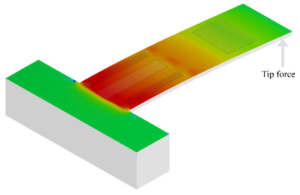 | N. F. S. de Bem; M. G. Ruppert; Y. K. Yong; A. J. Fleming Integrated force and displacement sensing in active microcantilevers for off-resonance tapping mode atomic force microscopy Proceedings Article In: International Conference on Manipulation, Automation and Robotics at Small Scales (MARSS), pp. 1-6, 2020, (This work was supported by the Australian Research Council Discovery Project DP170101813). Abstract | Links | BibTeX | Tags: AFM, DP170101813, MEMS, SPM @inproceedings{C20c,Integrated on-chip actuation and sensing in microcantilevers for atomic force microscopy (AFM) allows faster scanning speeds, cleaner frequency responses and smaller cantilevers. However, a single integrated sensor suffers from crosscoupling between displacements originating from tip-sample forces and direct actuation. This paper addresses this issue by presenting a novel microcantilever with on-chip actuation and integrated dual sensing for AFM with application to offresonance tapping modes in AFM. The proposed system is able to measure tip force and deflection simultaneously. A mathematical model is developed for a rectangular cantilever to describe the system and is validated with finite element analysis. |
| 27. | 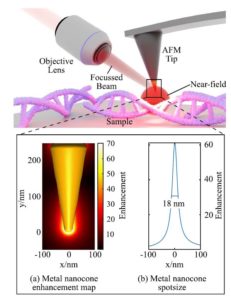 | L. McCourt; M. G. Ruppert; B. S. Routley; S. Indirathankam; A. J. Fleming A comparison of gold and silver nanocones and geometry optimisation for tip-enhanced microscopy Journal Article In: Journal of Raman Spectroscopy, vol. 51, iss. 11, pp. 2208-2216, 2020. Abstract | Links | BibTeX | Tags: AFM, Cantilever, MEMS, Optics, SPM @article{McCourt2020,In this article, boundary element method simulations are used to optimise the geometry of silver and gold nanocone probes to maximise the localised electric field enhancement and tune the near-field resonance wavelength. These objectives are expected to maximise the sensitivity of tip-enhanced Raman microscopes. Similar studies have used limited parameter sets or used a performance metric other than localised electric field enhancement. In this article, the optical responses for a range of nanocone geometries are simulated for excitation wavelengths ranging from 400 to 1000 nm. Performance is evaluated by measuring the electric field enhancement at the sample surface with a resonant illumination wavelength. These results are then used to determine empirical models and derive optimal nanocone geometries for a particular illumination wavelength and tip material. This article concludes that gold nanocones are expected to provide similar performance to silver nanocones at red and nearinfrared wavelengths, which is consistent with other results in the literature. In this article, 633 nm is determined to be the shortest usable illumination wavelength for gold nanocones. Below this limit, silver nanocones will provide superior enhancement. The use of gold nanocone probes is expected to dramatically improve probe lifetime, which is currently measured in hours for silver coated probes. Furthermore, the elimination of passivation coatings is expected to enable smaller probe radii and improved topographical resolution. |
| 26. | 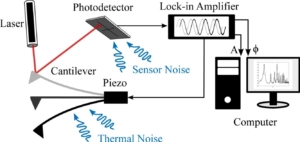 | M. G. Ruppert; N. J. Bartlett; Y. K. Yong; A. J. Fleming Amplitude Noise Spectrum of a Lock-in Amplifier: Application to Microcantilever Noise Measurements Journal Article In: Sensors and Actuators A: Physical, vol. 312, pp. 112092, 2020, (This work was supported by the Australian Research Council Discovery Project DP170101813). Abstract | Links | BibTeX | Tags: AFM, Cantilever, Demodulation, DP170101813, MEMS, System Identification @article{Ruppert2020,The lock-in amplifier is a crucial component in many applications requiring high-resolution displacement sensing; it's purpose is to estimate the amplitude and phase of a periodic signal, potentially corrupted by noise, at a frequency determined by a reference signal. Where the noise can be approximated by a stationary Gaussian process, such as thermal force noise and electronic sensor noise, this article derives the amplitude noise spectral density of the lock-in-amplifier output. The proposed method is demonstrated by predicting the demodulated noise spectrum of a microcantilever for dynamic-mode atomic force microscopy to determine the cantilever on-resonance thermal noise, the cantilever tracking bandwidth and the electronic noise floor. The estimates are shown to closely match experimental results over a wide range of operating conditions. |
| 25. | 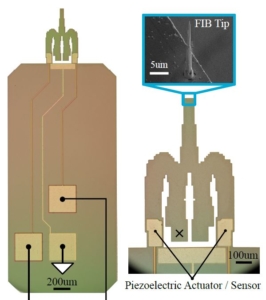 | S. I. Moore; M. G. Ruppert; Y. K. Yong AFM Cantilever Design for Multimode Q Control: Arbitrary Placement of Higher-Order Modes Journal Article In: IEEE/ASME Transactions on Mechatronics, pp. 1-6, 2020, (This work was supported by the Australian Research Council Discovery Project DP170101813). Abstract | Links | BibTeX | Tags: AFM, Cantilever, DP170101813, MEMS, Multifrequency AFM, Smart Structures, SPM, Vibration Control @article{Moore2020,In the fast growing field of multifrequency atomic force microscopy (AFM), the benefits of using higher-order modes has been extensively reported on. However, higher modes of AFM cantilevers are difficult to instrument and Q control is challenging owing to their high frequency nature. At these high frequencies, the latencies in the computations and analog conversions of digital signal processing platforms become significant and limit the effective bandwidth of digital feedback controller implementations. To address this issue, this article presents a novel cantilever design for which the first five modes are placed within a 200 kHz bandwidth. The proposed cantilever is designed using a structural optimization routine. The close spacing and low mechanical bandwidth of the resulting cantilever allows for the implementation of Q controllers for all five modes using a standard FPGA development board for bimodal AFM and imaging on higher-order modes. |
2019 |
||
| 24. | 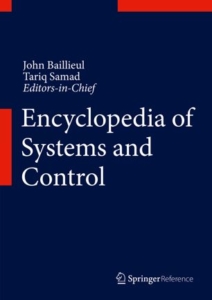 | M. G. Ruppert; S. O. R. Moheimani Dynamics and Control of Active Microcantilevers Book Chapter In: Baillieul, John; Samad, Tariq (Ed.): Encyclopedia of Systems and Control, vol. 2, Springer London, 2019, ISBN: 978-1-4471-5102-9. Abstract | Links | BibTeX | Tags: AFM, Cantilever, MEMS, Multifrequency AFM, Piezoelectric Transducers and Drives, Smart Structures, Vibration Control @inbook{Ruppert2019b,The microcantilever is a key precision mechatronic component of many technologies for characterization and manipulation of matter at the nanoscale, particularly in the atomic force microscope. When a cantilever is operated in a regime that requires the direct excitation and measurement of its resonance frequencies, appropriate instrumentation and control is crucial for high-performance operation. In this entry, we discuss integrated cantilever actuation and present the cantilever transfer function model and its properties. As a result of using these active cantilevers, the ability to control the quality factor in order to manipulate the cantilever tracking bandwidth is demonstrated. |
| 23. | 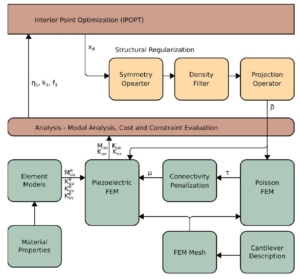 | S. I. Moore; M. G. Ruppert; Y. K. Yong An optimization framework for the design of piezoelectric AFM cantilevers Journal Article In: Precision Engineering, vol. 60, pp. 130-142, 2019, (This work was supported by the Australian Research Council Discovery Project DP170101813). Abstract | Links | BibTeX | Tags: AFM, Cantilever, DP170101813, MEMS, Piezoelectric Transducers and Drives, Smart Structures, SPM @article{Moore2019c,To facilitate further miniaturization of atomic force microscopy (AFM) cantilevers and to eliminate the standard optical beam deflection sensor, integrated piezoelectric actuation and sensing on the chip level is a promising option. This article presents a topology optimization method for dynamic mode AFM cantilevers that maximizes the sensitivity of an integrated piezoelectric sensor under stiffness and resonance frequency constraints. Included in the formulation is a new material model C-SIMP (connectivity and solid isotropic material with penalization) that extends the SIMP model to explicitly include the penalization of unconnected structures. Example cantilever designs demonstrate the potential of the topology optimization method. The results show, firstly, the C-SIMP material model significantly reduces connectivity issues and, secondly, arbitrary cantilever topologies can produce increases in sensor sensitivity or resonance frequency compared to a rectangular topology. |
| 22. | 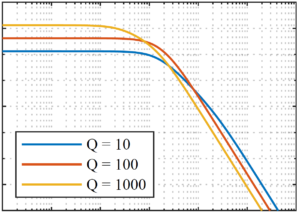 | D. M. Harcombe; M. G. Ruppert; A. J. Fleming Modeling and Noise Analysis of a Microcantilever-based Mass Sensor Proceedings Article In: Int. Conference on Manipulation, Automation and Robotics at Small Scales (MARSS), Helsinki, Finland, 2019, ISSN: 978-1-7281-0948-0. Abstract | Links | BibTeX | Tags: AFM, Cantilever, MEMS, Sensors, Smart Structures @inproceedings{Harcombe2019,Nanomechanical devices have the potential for practical applications as mass sensors. In microcantilever based sensing, resonance frequency shifts are tracked by a phase-locked loop (PLL) in-order to monitor mass adsorption. A major challenge in minimizing the mass detection limit comes from the noise present in the system due to thermal, sensor and oscillator noise. There is numerical difficulty in simulating PLLs, as both low frequency phase estimates and high frequency mixing products need to be captured resulting in a stiff problem. By using linear system-theoretic modeling an in-depth analysis of the system is able to be conducted overcoming this issue. This provides insight into individual noise source propagation, dominant noise sources and possible ways to reduce their effects. The developed model is verified in simulation against the non-linear PLL, with each achieving low picogram sensitivity for a 100 Hz loop bandwidth and realistically modeled noise sources. |
| 21. | 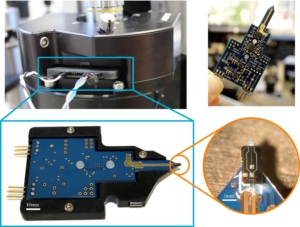 | M. G. Ruppert; S. I. Moore; M. Zawierta; A. J. Fleming; G. Putrino; Y. K. Yong Multimodal atomic force microscopy with optimized higher eigenmode sensitivity using on-chip piezoelectric actuation and sensing Journal Article In: Nanotechnology, vol. 30, no. 8, pp. 085503, 2019, (This work was supported by the Australian Research Council Discovery Project DP170101813). Abstract | Links | BibTeX | Tags: AFM, Cantilever, DP170101813, MEMS, Multifrequency AFM, Piezoelectric Transducers and Drives, Sensors, Smart Structures, SPM @article{Ruppert2018b,Atomic force microscope (AFM) cantilevers with integrated actuation and sensing provide several distinct advantages over conventional cantilever instrumentation. These include clean frequency responses, the possibility of down-scaling and parallelization to cantilever arrays as well as the absence of optical interference. While cantilever microfabrication technology has continuously advanced over the years, the overall design has remained largely unchanged; a passive rectangular shaped cantilever design has been adopted as the industry wide standard. In this article, we demonstrate multimode AFM imaging on higher eigenmodes as well as bimodal AFM imaging with cantilevers using fully integrated piezoelectric actuation and sensing. The cantilever design maximizes the higher eigenmode deflection sensitivity by optimizing the transducer layout according to the strain mode shape. Without the need for feedthrough cancellation, the read-out method achieves close to zero actuator/sensor feedthrough and the sensitivity is sufficient to resolve the cantilever Brownian motion. |
2018 |
||
| 20. | 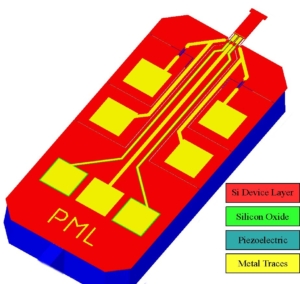 | M. G. Ruppert; Y. K. Yong Design of Hybrid Piezoelectric/Piezoresistive Cantilevers for Dynamic-mode Atomic Force Microscopy Proceedings Article In: IEEE/ASME Advanced Intelligent Mechatronics (AIM), Auckland, New Zealand, 2018, (This work was supported by the Australian Research Council Discovery Project DP170101813). Abstract | BibTeX | Tags: AFM, Cantilever, DP170101813, MEMS, Piezoelectric Transducers and Drives, Sensors, Smart Structures, SPM @inproceedings{Ruppert2018b,Atomic force microscope cantilevers with integrated actuation and sensing on the chip level provide several distinct advantages over conventional cantilever instrumentation. These include clean frequency responses, the possibility of down-scaling and parallelization to cantilever arrays as well as the absence of optical interferences. However, the two major difficulties with integrated transduction methods are a complicated fabrication process, often involving a number of fabrication steps, and a high amount of feedthrough from actuation to sensing electrodes. This work proposes two hybrid cantilever designs with piezoelectric actuators and piezoresistive sensors to reduce the actuator to sensor feedthrough. The designs can be realized using a commercial microelectromechanical systems fabrication process and only require a simple five-mask patterning and etching process. Finite element analysis results are presented to obtain modal responses, actuator gain and sensor sensitivities of the cantilever designs. |
| 19. |  | S. I. Moore; M. G. Ruppert; Y. K. Yong Arbitrary placement of AFM cantilever higher eigenmodes using structural optimization Proceedings Article In: International Conference on Manipulation, Automation and Robotics at Small Scales (MARSS), 2018, (This work was supported by the Australian Research Council Discovery Project DP170101813). Abstract | BibTeX | Tags: AFM, Cantilever, DP170101813, MEMS, Multifrequency AFM, Piezoelectric Transducers and Drives, Sensors, SPM, System Identification @inproceedings{Moore2018,This article presents a novel cantilever design approach to place higher mode frequencies within a specific frequency band to alleviate instrumentation and Q control feasibility. This work is motivated by the emerging field of multifrequency atomic force microscopy (AFM) which involves the excitation and/or detection of several cantilever modes at once. Unlike other operating modes, multifrequency AFM allows the tracking of the sample topography on the fundamental mode while simultaneously acquiring complimentary nanomechanical information on a higher mode. However, higher modes of conventional rectangular tapping-mode cantilevers are usually in the MHz regime and therefore impose severe restrictions on the direct controllability of these modes. To overcome this limitation, an optimization technique is employed which is capable of placing the first five modes within a 200 kHz bandwidth. |
| 18. |  | M. G. Ruppert Self-sensing, estimation and control in multifrequency Atomic Force Microscopy. Journal Article In: Journal & Proceedings of the Royal Society of New South Wales, vol. 151, no. 1, pp. 111, 2018, ISSN: 0035-9173/18/010111-01. Abstract | Links | BibTeX | Tags: Cantilever, MEMS, Multifrequency AFM, Sensors, Smart Structures, SPM, System Identification, Vibration Control @article{Ruppert2018b,Despite the undeniable success of the atomic force microscope (AFM), dynamic techniques still face limitations in terms of spatial resolution, imaging speed and high cost of acquisition. In order to expand the capabilities of the instrument, it was realized that the information about the nano-mechanical properties of a sample are encoded over a range of frequencies and the excitation and detection of higher-order eigenmodes of the micro-cantilever open up further informa- tion channels. The ability to control these modes and their fast responses to excitation is believed to be the key to unravelling the true potential of these ethods. This work addresses three major drawbacks of the standard AFM setup, which limit the feasibility of multi-frequency approaches. First, microelectromechanical system (MEMS) probes with integrated piezoelectric layers is motivated, enabling the development of novel multimode self-sensing and self-actuating techniques. Specifically, these piezoelectric transduction schemes permit the miniaturization of the entire AFM towards a cost-effective single-chip device with nanoscale precision in a much smaller form factor than that of conventional macroscale instruments. Second, the integrated actuation enables the development of multimode controllers which exhibits remarkable performance in arbitrarily modifying the quality factor of multiple eigenmodes and comes with inherent stability robustness. The experimental results demonstrate improved imaging stability, higher scan speeds and adjustable contrast when mapping nano-mechanical properties of soft samples. Last, in light of the demand for constantly increasing imaging speeds while providing multi-frequency flexibility, the estimation of multiple components of the high-frequency deflection signal is performed with a linear time-varying multi-frequency Kalman filter. The chosen representation allows for an efficient high-bandwidth implementation on a Field Programmable Gate Array. Tracking bandwidth, noise performance and trimodal AFM imaging on a two-component polymer sample are verified and shown to be superior to that of the commonly used lock-in amplifier. |
| 17. | 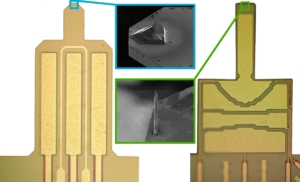 | M. G. Ruppert; S. I. Moore; M. Zawierta; G. Putrino; Y. K. Yong Advanced Sensing and Control with Active Cantilevers for Multimodal Atomic Force Microscopy Conference 7th Multifrequency AFM Conference, Madrid, Spain, 2018, (This work was supported by the Australian Research Council Discovery Project DP170101813). Abstract | BibTeX | Tags: AFM, Cantilever, DP170101813, MEMS, Multifrequency AFM, Sensors, Smart Structures, SPM, Vibration Control @conference{Ruppert2018,Atomic force microscopy (AFM) cantilevers with integrated actuation and sensing on the chip level provide several distinct advantages over conventional cantilever instrumentation. These include clean frequency responses, the possibility of down-scaling and parallelization to cantilever arrays as well as the absence of optical interferences. While cantilever microfabrication technology has continuously advanced over the years, the overall design has remained largely unchanged; a passive rectangular shaped cantilever design has been adopted as the industry wide standard. Consequently, conventional cantilever instrumentation requires external piezo acoustic excitation as well as an external optical deflection sensor. Both of these components are not optimal for current trends in multifrequency AFM technology which revolve around further down-sizing, parallelization and measurements at multiple higher eigenmodes. Using microelectromechanical systems (MEMS) fabrication processes, this work aims to optimize cantilever instrumentation by realizing a new class of probes with high-performance integrated actuators and sensors. Equipped with multiple integrated piezoelectric layers for both actuation and sensing, these cantilevers are capable of achieving an increased higher eigenmode sensitivity and/or guaranteed collocated system properties compared to commercially available counterparts; examples of such designs are shown in Figure 1. The geometry as well as the integrated actuator/sensor arrangement is optimized using finite element modelling with individual design goals. The designs are realized using a commercial MEMS fabrication process and only require a simple five-mask patterning and etching process and post-fabricated sharp tips. |
2017 |
||
| 16. | 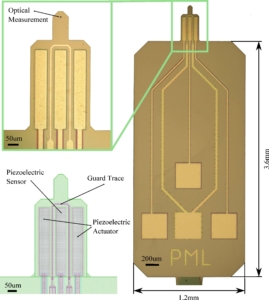 | M. G. Ruppert; Y. K. Yong Note: Guaranteed collocated multimode control of an atomic force microscope cantilever using on-chip piezoelectric actuation and sensing Journal Article In: Review of Scientific Instruments, vol. 88, no. 086109, 2017, (This work was supported by the Australian Research Council Discovery Project DP170101813). Abstract | Links | BibTeX | Tags: AFM, Cantilever, DP170101813, MEMS, Multifrequency AFM, Piezoelectric Transducers and Drives, System Identification, Vibration Control @article{Ruppert2017b,The quality (Q) factor is an important parameter of the resonance of the microcantilever as it determines both imaging bandwidth and force sensitivity. The ability to control the Q factor of multiple modes is believed to be of great benefit for atomic force microscopy techniques involving multiple eigenmodes. In this paper, we propose a novel cantilever design employing multiple piezoelectric transducers which are used for separated actuation and sensing, leading to guaranteed collocation of the first eight eigenmodes up to 3 MHz. The design minimizes the feedthrough usually observed with these systems by incorporating a guard trace on the cantilever chip. As a result, a multimode Q controller is demonstrated to be able to modify the quality factor of the first two eigenmodes over up to four orders of magnitude without sacrificing robust stability. |
| 15. | 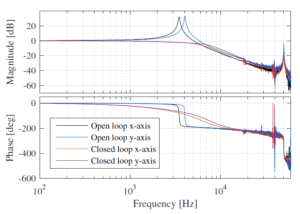 | M. G. Ruppert; M. Maroufi; A. Bazaei; S. O. R. Moheimani Kalman Filter Enabled High-Speed Control of a MEMS Nanopositioner Proceedings Article In: 20th IFAC World Congress, pp. 15554-15560, 2017. Abstract | BibTeX | Tags: MEMS, Nanopositioning, Tracking Control, Vibration Control @inproceedings{Ruppert2017b,We demonstrate a novel tracking controller formulation based on a linear time-varying Kalman Filter to regulate amplitude and phase of a reference signal independently. The method is applicable to sinusoidal references such as spiral, cycloid and Lissajous trajectories which are commonly used for imaging in high-speed Atomic Force Microscopy (AFM). A Microelectromechanical Systems (MEMS) based nanopositioner, whose fundamental resonance frequency is dampened with an additional damping feedback loop, is employed. For a scan range of 2um, we demonstrate experimental tracking of sinusoids with frequencies as high as 5kHz, well beyond the open-loop fundamental resonance, with a tracking error of only 4.6nm. |
| 14. | 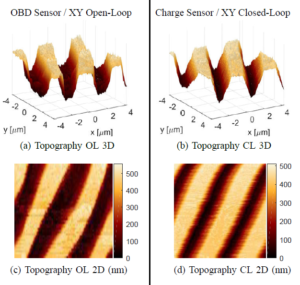 | M. Maroufi; M. G. Ruppert; A. G. Fowler; S. O. R. Moheimani Design and Control of a Single-chip SOI-MEMS Atomic Force Microscope Proceedings Article In: American Control Conference, 2017. Abstract | BibTeX | Tags: MEMS, Nanopositioning, SPM, Tracking Control @inproceedings{Maroufi2017,This paper presents a novel microelectromechanical systems (MEMS) implementation of an on-chip atomic force microscope (AFM), fabricated using a silicon-on-insulator process. The device features an XY scanner with electrostatic actuators and electrothermal sensors, as well as an integrated silicon microcantilever. A single AlN piezoelectric electrode is used for simultaneous actuation and deflection sensing of the cantilever via a charge sensing technique. With the device being operated in closed loop, the probe scanner is successfully used to obtain 8mmx8mm tapping-mode AFM images of a calibration grating. |
| 13. | 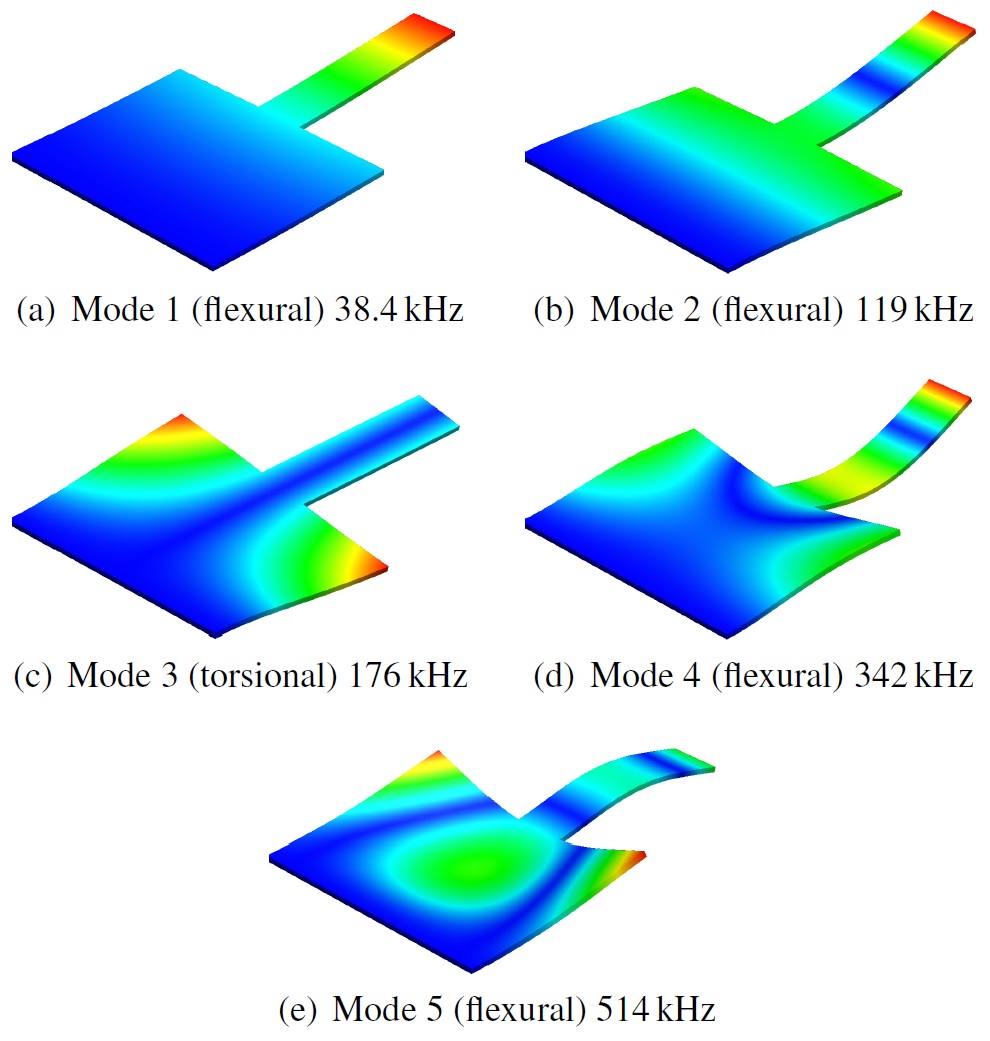 | S. I. Moore; Y. K. Yong Design and Characterization of Cantilevers for Multi-Frequency Atomic Force Microscopy Journal Article In: Micro & Nano Letters, vol. 12, no. 5, pp. 315-320, 2017, (This work was supported by the Australian Research Council Discovery Project DP170101813). Abstract | Links | BibTeX | Tags: Cantilever, DP170101813, MEMS, Multifrequency AFM, SPM @article{Moore2017,The experimental characterisation of a set of microcantilevers targeted at use in multi-frequency atomic force microscope is presented. The aim of this work is to design a cantilever that naturally amplifies its harmonic oscillations which are introduced by nonlinear probe–sample interaction forces. This is performed by placing the modal frequencies of the cantilever at integer multiples of the first modal frequency. The developed routine demonstrates the placement of the frequency of the second to fifth mode. The characterisation shows a trend that lower-order modes are more accurately placed than higher-order modes. With two fabricated designs, the error in the second mode is at most 2.26% while the greatest error in the fifth mode is at 10.5%. |
| 12. | 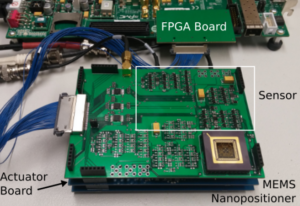 | S. I. Moore; Y. K. Yong; S. O. R. Moheimani Switched Self-Sensing Actuator for a MEMS Nanopositioner Proceedings Article In: International Conference on Mechatronics, Gippsland, Australia, 2017. Abstract | Links | BibTeX | Tags: MEMS, Nanopositioning, Sensors @inproceedings{Moore2017b,This work outlines the instrumentation and actuation of a MEMS nanopositioner, implementing a switching electronics based self-sensing actuation technique. Self-sensing actuation allows for optimal use of transducer die space in MEMS designs. The switching design accommodates actuation voltages of 50V and is compatible with the silicon-on-insulator microfabrication process. The switching electronics are designed to be directly interfaced to a digital control platform. The actuator is based on the class D amplifier and the sensor is implemented using a modulator to create a displacement-to-digital type sensor that is operated at 1MHz. |
| 11. |  | M. G. Ruppert; A. G. Fowler; M. Maroufi; S. O. R. Moheimani On-chip Dynamic Mode Atomic Force Microscopy: A silicon-on-insulator MEMS approach Journal Article In: IEEE Journal of Microelectromechanical Systems, vol. 26, no. 1, pp. 215-225, 2017. Abstract | Links | BibTeX | Tags: MEMS, Nanopositioning, Piezoelectric Transducers and Drives, Sensors, Smart Structures, SPM, Tracking Control @article{Ruppert2017,The atomic force microscope (AFM) is an invaluable scientific tool; however, its conventional implementation as a relatively costly macroscale system is a barrier to its more widespread use. A microelectromechanical systems (MEMS) approach to AFM design has the potential to significantly reduce the cost and complexity of the AFM, expanding its utility beyond current applications. This paper presents an on-chip AFM based on a silicon-on-insulator MEMS fabrication process. The device features integrated xy electrostatic actuators and electrothermal sensors as well as an AlN piezoelectric layer for out-of-plane actuation and integrated deflection sensing of a microcantilever. The three-degree-of-freedom design allows the probe scanner to obtain topographic tapping-mode AFM images with an imaging range of up to 8μm x 8μm in closed loop. |
2016 |
||
| 10. | 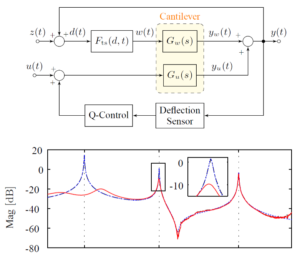 | M. G. Ruppert; S. O. R. Moheimani Multimode Q Control in Tapping-Mode AFM: Enabling Imaging on Higher Flexural Eigenmodes Journal Article In: IEEE Transactions on Control Systems Technology, vol. 24, no. 4, pp. 1149-1159, 2016. Abstract | Links | BibTeX | Tags: MEMS, Multifrequency AFM, SPM, System Identification, Vibration Control @article{Ruppert2016b,Numerous dynamic Atomic Force Microscopy (AFM) methods have appeared in recent years, which make use of the excitation and detection of higher order eigenmodes of the microcantilever. The ability to control these modes and their responses to excitation is believed to be the key to unraveling the true potential of these methods. In this work, we highlight a multi-mode Q control method that exhibits remarkable damping performance and stability robustness. The experimental results obtained in ambient conditions demonstrate improved imaging stability by damping non-driven resonant modes when scanning is performed at a higher eigenmode of the cantilever. Higher scan speeds are shown to result from a decrease in transient response time. |
| 9. | 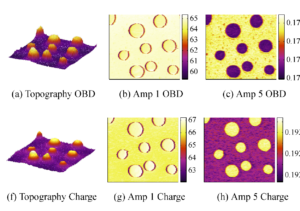 | M. G. Ruppert; S. O. R. Moheimani High-bandwidth Multimode Self-sensing in Bimodal Atomic Force Microscopy Journal Article In: Beilstein Journal of Nanotechnology, vol. 7, pp. 284-295, 2016. Abstract | Links | BibTeX | Tags: MEMS, Multifrequency AFM, Piezoelectric Transducers and Drives, Vibration Control @article{Ruppert2016b,Using standard microelectromechanical system (MEMS) processes to coat a microcantilever with a piezoelectric layer results in a versatile transducer with inherent self-sensing capabilities. For applications in multifrequency atomic force microscopy (MF-AFM), we illustrate that a single piezoelectric layer can be simultaneously used for multimode excitation and detection of the cantilever deflection. This is achieved by a charge sensor with a bandwidth of 10 MHz and dual feedthrough cancellation to recover the resonant modes that are heavily buried in feedthrough originating from the piezoelectric capacitance. The setup enables the omission of the commonly used piezoelectric stack actuator and optical beam deflection sensor, alleviating limitations due to distorted frequency responses and instrumentation cost, respectively. The proposed method benefits from a more than two orders of magnitude increase in deflection to strain sensitivity on the fifth eigenmode leading to a remarkable signal-to-noise ratio. Experimental results using bimodal AFM imaging on a two component polymer sample validate that the self-sensing scheme can therefore be used to provide both the feedback signal, for topography imaging on the fundamental mode, and phase imaging on the higher eigenmode. |
2015 |
||
| 8. | 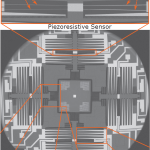 | M. Maroufi; Y. K. Yong; S. O. R. Moheimani Design and Control of a MEMS Nanopositioner with Bulk Piezoresistive Sensors Proceedings Article In: IEEE Multiconference on Systems and Control, Sydney, Australia, 2015. Abstract | Links | BibTeX | Tags: MEMS, Nanopositioning, Sensors, SPM @inproceedings{Maroufi2015,A 2 degree of freedom microelectromechanical system (MEMS) nanopositioner is presented in this paper. The nanopositioner is fabricated using a standard silicon-on-insulator process. The device demonstrates a bidirectional displacement in two orthogonal directions. As the displacement sensing mechanism, bulk piezoresistivity of tilted clamped-guided beams is exploited. The characterization reveals more than 15 μm displacement range and an in-plane bandwidth of above 3.6 kHz in both axes. The piezoresistive sensors provide a bandwidth which is more than ten times larger than the stage's resonant frequency. To evaluate the sensor performance in closed-loop, an integral resonant controller together with an integral tracking controller are implemented where piezoresistive sensor outputs are used as measurement. The controlled nanopositioner is used for imaging in an atomic force microscope. |
| 7. | 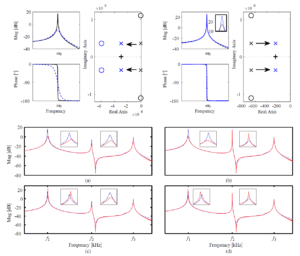 | M. G. Ruppert; S. O. R. Moheimani Multi-Mode Q Control in Multifrequency Atomic Force Microscopy Proceedings Article In: ASME International Design Engineering Technical Conferences & Computers and Information in Engineering Conference, pp. V004T09A009, Boston, Massachusetts, USA, 2015. Abstract | Links | BibTeX | Tags: MEMS, Multifrequency AFM, SPM, Vibration Control @inproceedings{Ruppert2015,Various Atomic Force Microscopy (AFM) modes have emerged which rely on the excitation and detection of multiple eigenmodes of the microcantilever. The conventional control loops employed in multifrequency AFM (MF-AFM) such as bimodal imaging where the fundamental mode is used to map the topography and a higher eigenmode is used to map sample material properties only focus on maintaining low bandwidth signals such as amplitude and/ or frequency shift. However, the ability to perform additional high bandwidth control of the quality (Q) factor of the participating modes is believed to be imperative to unfolding the full potential of these methods. This can be achieved by employing a multi-mode Q control approach utilizing positive position feedback. The controller exhibits remarkable performance in arbitrarily modifying the Q factor of multiple eigenmodes as well as guaranteed stability properties when used on flexible structures with collocated actuators and sensors. A controller design method based on pole placement optimization is proposed for setting an arbitrary on-resonance Q factor of the participating eigenmodes. Experimental results using bimodal AFM imaging on a two component polymer sample are presented. |
| 6. | 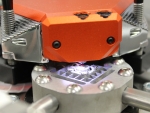 | Y. K. Yong; S. O. R. Moheimani Control of vertical axis of a video-speed AFM nanopositioner (Invited Paper) Proceedings Article In: American Control Conference, Chicago, USA, pp. 3473-3477, 2015. BibTeX | Tags: MEMS, Nanopositioning, SPM @inproceedings{Yong20153473, |
2014 |
||
| 5. | 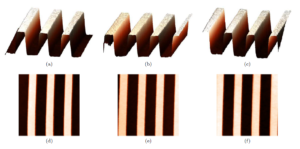 | M. G. Ruppert; S. O. R. Moheimani Novel Reciprocal Self-Sensing Techniques for Tapping-Mode Atomic Force Microscopy Proceedings Article In: 19th IFAC World Congress, Cape Town, South Africa, 2014. Abstract | Links | BibTeX | Tags: MEMS, Smart Structures, SPM @inproceedings{Ruppert2014,We evaluate two novel reciprocal self-sensing methods for tapping-mode atomic force microscopy (TM-AFM) utilizing charge measurement and charge actuation, respectively. A microcantilever, which can be batch fabricated through a standard microelectromechanical system (MEMS) process, is coated with a single piezoelectric layer and simultaneously used for actuation and deflection sensing. The setup enables the elimination of the optical beam deflection technique which is commonly used to measure the cantilever oscillation amplitude. The voltage to charge and charge to voltage transfer functions reveal a high amount of capacitive feedthrough which degrades the dynamic range of the sensors significantly. A feedforward control technique is employed to cancel the feedthrough and increase the dynamic range from less than 1 dB to approximately 30 dB. Experiments show that the conditioned self-sensing schemes achieve an excellent signal-to-noise ratio and can therefore be used to provide the feedback signal for TM-AFM imaging. |
| 4. | 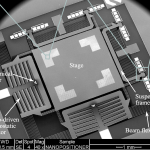 | A. Mohammadi; A. G. Fowler; Y. K. Yong; S. O. R. Moheimani A feedback controlled MEMS nanopositioner for on-chip high-speed AFM Journal Article In: Journal of Microelectromechanical Systems, vol. 23, no. 3, pp. 610-619, 2014. Links | BibTeX | Tags: MEMS, Nanopositioning @article{Mohammadi2014610, |
2013 |
||
| 3. | 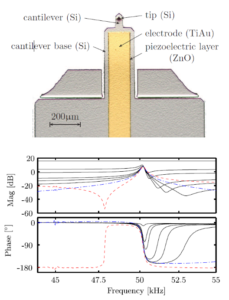 | M. G. Ruppert; S. O. R. Moheimani A novel self-sensing technique for tapping-mode atomic force microscopy Journal Article In: Review of Scientific Instruments, vol. 84, no. 12, pp. 125006, 2013. Abstract | Links | BibTeX | Tags: MEMS, Smart Structures, SPM, System Identification @article{Ruppert2013b,This work proposes a novel self-sensing tapping-mode atomic force microscopy operation utilizing charge measurement. A microcantilever coated with a single piezoelectric layer is simultaneously used for actuation and deflection sensing. The cantilever can be batch fabricated with existing Micro Electro Mechanical System processes. The setup enables the omission of the optical beam deflection technique which is commonly used to measure the cantilever oscillation amplitude. Due to the high amount of capacitive feedthrough in the measured charge signal, a feedforward control technique is employed to increase the dynamic range from less than 1dB to approximately 35dB. Experiments show that the conditioned charge signal achieves excellent signal-to-noise ratio and can therefore be used as a feedback signal for AFM imaging. |
| 2. | 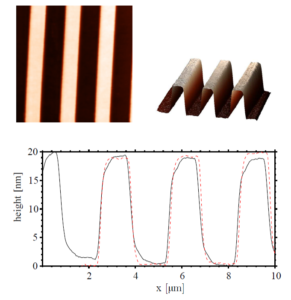 | M. G. Ruppert; M. Fairbairn; S. O. R. Moheimani Multi-Mode Resonant Control of a Microcantilever for Atomic Force Microscopy Proceedings Article In: IEEE/ASME International Conference on Advanced Intelligent Mechatronics, pp. 77-82, Wollongong, Australia, 2013. Abstract | Links | BibTeX | Tags: MEMS, Multifrequency AFM, Vibration Control @inproceedings{Ruppert2013,When operating the Atomic Force Microscope in tapping mode it is possible to decrease the quality factor of the microcantilever to enhance scan speed. %Standard Q Control techniques involve velocity feedback with the disadvantage of additional sensor equipment, or time-delay position feedback which may lead to instabilities of out-of-bandwidth modes.Various resonance controllers have been proposed which do not rely on expensive velocity sensors and guarantee stability of the closed loop system even in the presence of unmodeled dynamics. A new field of Atomic Force Microscopy is evolving, which makes use of multiple frequency excitation and detection of the cantilever modes making it necessary to be able to control these modes and their response to excitation. This work proposes a multi-mode Q control approach utilizing positive position feedback, offering full control over the first two flexural modes of the cantilever. By completely damping the first mode and adjusting the quality factor of the second mode, it is possible to scan and obtain images at the second resonance frequency which improves image quality at high scan speeds due to the increased bandwidth of the z-axis feedback loop. |
| 1. |  | Y. K. Yong; A. G. Fowler; A. Mohammadi; S. O. R. Moheimani Control of a MEMS nanopositioner for atomic force microscopy (Invited Paper) Proceedings Article In: Proc. IFAC Symposium on Mehatronic Systems, Hangzhou, China, pp. 375-382, 2013. Links | BibTeX | Tags: MEMS, Nanopositioning, SPM @inproceedings{Yong2013375, |
2021 |
||
| 30. |  | Characterization of Active Microcantilevers Using Laser Doppler Vibrometry Book Chapter In: Vibration Engineering for a Sustainable Future , Chapter 45, Springer, 2021, ISBN: 978-3-030-48153-7, (This work was supported by the Australian Research Council Discovery Project DP170101813). |
| 29. |  | Active atomic force microscope cantilevers with integrated device layer piezoresistive sensors Journal Article In: Sensors & Actuators: A. Physical, vol. 319, pp. 112519, 2021, ISSN: 0924-4247, (This work was supported by the Australian Research Council Discovery Project DP170101813). |
2020 |
||
| 28. |  | Integrated force and displacement sensing in active microcantilevers for off-resonance tapping mode atomic force microscopy Proceedings Article In: International Conference on Manipulation, Automation and Robotics at Small Scales (MARSS), pp. 1-6, 2020, (This work was supported by the Australian Research Council Discovery Project DP170101813). |
| 27. |  | A comparison of gold and silver nanocones and geometry optimisation for tip-enhanced microscopy Journal Article In: Journal of Raman Spectroscopy, vol. 51, iss. 11, pp. 2208-2216, 2020. |
| 26. |  | Amplitude Noise Spectrum of a Lock-in Amplifier: Application to Microcantilever Noise Measurements Journal Article In: Sensors and Actuators A: Physical, vol. 312, pp. 112092, 2020, (This work was supported by the Australian Research Council Discovery Project DP170101813). |
| 25. |  | AFM Cantilever Design for Multimode Q Control: Arbitrary Placement of Higher-Order Modes Journal Article In: IEEE/ASME Transactions on Mechatronics, pp. 1-6, 2020, (This work was supported by the Australian Research Council Discovery Project DP170101813). |
2019 |
||
| 24. |  | Dynamics and Control of Active Microcantilevers Book Chapter In: Baillieul, John; Samad, Tariq (Ed.): Encyclopedia of Systems and Control, vol. 2, Springer London, 2019, ISBN: 978-1-4471-5102-9. |
| 23. |  | An optimization framework for the design of piezoelectric AFM cantilevers Journal Article In: Precision Engineering, vol. 60, pp. 130-142, 2019, (This work was supported by the Australian Research Council Discovery Project DP170101813). |
| 22. |  | Modeling and Noise Analysis of a Microcantilever-based Mass Sensor Proceedings Article In: Int. Conference on Manipulation, Automation and Robotics at Small Scales (MARSS), Helsinki, Finland, 2019, ISSN: 978-1-7281-0948-0. |
| 21. |  | Multimodal atomic force microscopy with optimized higher eigenmode sensitivity using on-chip piezoelectric actuation and sensing Journal Article In: Nanotechnology, vol. 30, no. 8, pp. 085503, 2019, (This work was supported by the Australian Research Council Discovery Project DP170101813). |
2018 |
||
| 20. |  | Design of Hybrid Piezoelectric/Piezoresistive Cantilevers for Dynamic-mode Atomic Force Microscopy Proceedings Article In: IEEE/ASME Advanced Intelligent Mechatronics (AIM), Auckland, New Zealand, 2018, (This work was supported by the Australian Research Council Discovery Project DP170101813). |
| 19. |  | Arbitrary placement of AFM cantilever higher eigenmodes using structural optimization Proceedings Article In: International Conference on Manipulation, Automation and Robotics at Small Scales (MARSS), 2018, (This work was supported by the Australian Research Council Discovery Project DP170101813). |
| 18. |  | Self-sensing, estimation and control in multifrequency Atomic Force Microscopy. Journal Article In: Journal & Proceedings of the Royal Society of New South Wales, vol. 151, no. 1, pp. 111, 2018, ISSN: 0035-9173/18/010111-01. |
| 17. |  | Advanced Sensing and Control with Active Cantilevers for Multimodal Atomic Force Microscopy Conference 7th Multifrequency AFM Conference, Madrid, Spain, 2018, (This work was supported by the Australian Research Council Discovery Project DP170101813). |
2017 |
||
| 16. |  | Note: Guaranteed collocated multimode control of an atomic force microscope cantilever using on-chip piezoelectric actuation and sensing Journal Article In: Review of Scientific Instruments, vol. 88, no. 086109, 2017, (This work was supported by the Australian Research Council Discovery Project DP170101813). |
| 15. |  | Kalman Filter Enabled High-Speed Control of a MEMS Nanopositioner Proceedings Article In: 20th IFAC World Congress, pp. 15554-15560, 2017. |
| 14. |  | Design and Control of a Single-chip SOI-MEMS Atomic Force Microscope Proceedings Article In: American Control Conference, 2017. |
| 13. |  | Design and Characterization of Cantilevers for Multi-Frequency Atomic Force Microscopy Journal Article In: Micro & Nano Letters, vol. 12, no. 5, pp. 315-320, 2017, (This work was supported by the Australian Research Council Discovery Project DP170101813). |
| 12. |  | Switched Self-Sensing Actuator for a MEMS Nanopositioner Proceedings Article In: International Conference on Mechatronics, Gippsland, Australia, 2017. |
| 11. |  | On-chip Dynamic Mode Atomic Force Microscopy: A silicon-on-insulator MEMS approach Journal Article In: IEEE Journal of Microelectromechanical Systems, vol. 26, no. 1, pp. 215-225, 2017. |
2016 |
||
| 10. |  | Multimode Q Control in Tapping-Mode AFM: Enabling Imaging on Higher Flexural Eigenmodes Journal Article In: IEEE Transactions on Control Systems Technology, vol. 24, no. 4, pp. 1149-1159, 2016. |
| 9. |  | High-bandwidth Multimode Self-sensing in Bimodal Atomic Force Microscopy Journal Article In: Beilstein Journal of Nanotechnology, vol. 7, pp. 284-295, 2016. |
2015 |
||
| 8. |  | Design and Control of a MEMS Nanopositioner with Bulk Piezoresistive Sensors Proceedings Article In: IEEE Multiconference on Systems and Control, Sydney, Australia, 2015. |
| 7. |  | Multi-Mode Q Control in Multifrequency Atomic Force Microscopy Proceedings Article In: ASME International Design Engineering Technical Conferences & Computers and Information in Engineering Conference, pp. V004T09A009, Boston, Massachusetts, USA, 2015. |
| 6. |  | Control of vertical axis of a video-speed AFM nanopositioner (Invited Paper) Proceedings Article In: American Control Conference, Chicago, USA, pp. 3473-3477, 2015. |
2014 |
||
| 5. |  | Novel Reciprocal Self-Sensing Techniques for Tapping-Mode Atomic Force Microscopy Proceedings Article In: 19th IFAC World Congress, Cape Town, South Africa, 2014. |
| 4. |  | A feedback controlled MEMS nanopositioner for on-chip high-speed AFM Journal Article In: Journal of Microelectromechanical Systems, vol. 23, no. 3, pp. 610-619, 2014. |
2013 |
||
| 3. |  | A novel self-sensing technique for tapping-mode atomic force microscopy Journal Article In: Review of Scientific Instruments, vol. 84, no. 12, pp. 125006, 2013. |
| 2. |  | Multi-Mode Resonant Control of a Microcantilever for Atomic Force Microscopy Proceedings Article In: IEEE/ASME International Conference on Advanced Intelligent Mechatronics, pp. 77-82, Wollongong, Australia, 2013. |
| 1. |  | Control of a MEMS nanopositioner for atomic force microscopy (Invited Paper) Proceedings Article In: Proc. IFAC Symposium on Mehatronic Systems, Hangzhou, China, pp. 375-382, 2013. |
